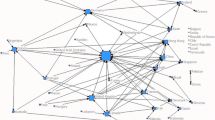Abstract
In literature, a large number of studies on the Italian districts exhibit a portrait which points out the Italian economic specificity. A specific feature of the Italian districts is the large number of collaborative actions carried on by the associated enterprises which are not limited to the solution of the usual supply chain management problems. As not all the collaborative actions bring immediate (and measurable) economic benefits, there is the need for a reliable and unbiased method aimed at the identification and analysis of the collaborative patterns inside an industry network, to determine their presence and effectiveness. The proposed method uses a graph representation of the inter-firm relationships inside a network and induces the presence of collaborative behaviours by the analysis of the graph topology.
Similar content being viewed by others
References
Abello, J., Resende, M. G. C., & Sudarsky, S. (2002). Massive quasi-clique detection. LATIN: Theoretical Informatics, 598–612. doi:10.1007/3-540-45995-2_51.
Albino V., Izzo C., Kuhtz S. (2002) Input-output models from the analysis of the local/global supply chain. International Journal of Production Economics 78: 119–131
Beccatini, G. (1990). The marshallian industrial district as socio-economic notion. In industrial districts and inter-firm co-operation in Italy (pp. 37–51). Geneva: International Institute for Labour Studies.
Bergman, E. M., & Feser, J. E. (1999). Industrial and regional clusters: Concepts and comparative applications. Available online at: http://www.rri.wvu.edu/WebBook/Bergman-Feser/contents.htm.
Bernus P., Nemes L. (1997) Requirements of the generic reference architecture and methodology. Annual Reviews in Control 21: 125–136
Bititci U. S., Martinez V., Albores P., Parung J. (2004) Creating and managing value in collaborative networks. International Journal of Physical Distribution & Logistics Management 34(3/4): 251–268
Bollobás B. (1978) Extremal graph theory. Academic Press, London
DeCanio S. J., Watkins E. (1998) Information processing and organizational structure. Journal of Economic Behavior & Organization 36(3): 275–294
Enright M. J. (1996) Regional clusters and economic development: A research agenda. In: Staber U. H., Schaefer N. V., Sharma B. (eds) Business networks: Prospects for regional development. Walter de Gruyter, Berlin
Gavirneni S., Kapuscinski R., Tayur S. (1999) Value of information in capacitated supply chains. Management Science 45(1): 16–24
Goyal S., Joshi S. (2003) Networks of collaboration in oligopoly. Games and Economic Behavior 43: 57–85
Gross, J. L., & Yellen, J. (1998). Graph theory and its applications. CRC Press.
Huxham C. (1996) Creating collaborative advantage. Sage Publications, London
Kreher D. L., Stinson D. R. (1998) Combinatorial algorithms. CRC Press, Boca Raton
Lewis D. J. (1990) Partnership for profit: Structuring and maintaining strategic alliances. The Free Press, New York
Love J., Roper S. (2001) Location and network effects on innovation success: Evidence for UK, German and Irish manufacturing plants. Research Policy 30: 643–661
Nix, N., Zacharia, Z. G., Lusch, R. F., Bridges, W. R., & Thomas, A. (2004). Keys to effective supply chain collaboration: A special report from the collaborative practices research program, The M. J. Neeley School of Business TCU.
Pei, J., Jiang, D., & Zhang, A. (2004). On mining cross-graph quasi-cliques. Technical Report TR 2004-15, School of Computing Science, Simon Fraser University.
Rosenfeld S. (1995) Industrial strength strategies: Regional business clusters and public policy. Aspen Institute, Washington DC
Supply Chain Council. (2006). Manual of supply-chain operations reference-model: SCOR Version 8.0 overview
Valiente G. (2002) Algorithms on trees and graphs. Springer, Heidelberg
Zwegers, A., Tølle, M., & Vesterager, J. (2002). VERAM: Virtual enterprise reference architecture and methodology. Global Engineering and Manufacturing in Enterprise Networks, GLOBEMEN, VTT Symposium 224.
Author information
Authors and Affiliations
Corresponding author
Rights and permissions
About this article
Cite this article
Antonelli, D., Caroleo, B. An integrated methodology for the analysis of collaboration in industry networks. J Intell Manuf 23, 2443–2450 (2012). https://doi.org/10.1007/s10845-011-0510-z
Received:
Accepted:
Published:
Issue Date:
DOI: https://doi.org/10.1007/s10845-011-0510-z




